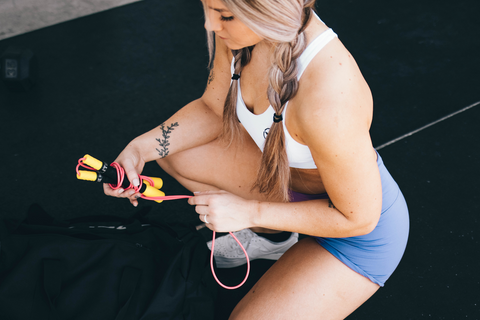8 Common Jump Rope Mistakes
May 29, 2024Devin Meek

Jump rope is a fantastic way to boost your cardiovascular fitness, improve coordination, and build strength. But like any exercise, it's easy to make mistakes that can hinder your progress and even lead to injury. At Elite Jumps, we've seen it all. In this post, we'll examine the most common jump rope mistakes and how you can correct them to ensure your workouts are safer and more effective.
One of the most common mistakes we see is excessive arm movement. Your wrists and forearms should be doing most of the work, not your entire arms. When you swing your arms too much, you tire out quickly and lose efficiency.
How to Fix It:
Focus on rotating the rope with your wrists and keep your arms relaxed by your sides. This will help you maintain a steady rhythm and conserve energy for longer jumping sessions.
Jumping too high is another common issue, especially for beginners. While it may seem like a higher jump is better, it actually wastes energy and makes it harder to maintain a steady pace.
How to Fix It:
Aim to jump just high enough for the rope to pass under your feet. This typically means keeping your jumps around 1-2 inches off the ground. Practice small, controlled jumps to improve your efficiency.
Tuck jumps involve pulling your knees up towards your chest while jumping. While this might be useful for some advanced multiple under skills, it’s unnecessary for basic jump rope exercises and can lead to fatigue and poor form.
How to Fix It:
Keep your legs relatively straight (not locked out) and your feet close together as you jump. Focus on a light bounce and quiet landings rather than a high tuck to maintain control and reduce the risk of injury.
Pike jumps occur when you jump with your legs extended in front of you, resembling a pike position. This mistake not only makes jumping more difficult but also impairs balance and puts unnecessary strain on your lower back.
How to Fix It:
Maintain a natural, upright posture with your feed directly underneath your hips. This position allows for a smoother, more efficient jump and reduces the risk of lower back pain.
Donkey kicks happen when you kick your feet backward while jumping, often as a result of trying to clear the rope with excessive movement. This can lead to instability and wasted energy.
How to Fix It:
Focus on keeping your feet directly beneath you. Imagine bouncing on the balls of your feet without any backward kick. This will help you stay balanced and use your energy more efficiently.
This happens when one of your arms does all the work. Essentially, one hand is turning the rope and the other hand is not. This one can be hard to diagnose unless you jump in front of a mirror or have someone watch you jump because it may not be obvious to your brain that one arm is “lazy.” If you’re having trouble developing a consistent rhythm or jumping for long periods of time without messing up, it’s worth looking for this and getting some feedback.
How to Fix It:
The best solution to this is to use a cordless jump rope to train your brain and hand to turn both handles at the same time. You’ll notice right away that one hand isn’t working because the ball on that end won’t spin.
Drifting hands refer to the habit of letting your hands move away from your body as you jump. This can cause the rope to shorten and make jumping more difficult.
How to Fix It:
Keep your hands close to your hips and your elbows slightly bent. This position helps maintain the proper rope length and allows for a more efficient rotation. If this is a persistent problem for you, be sure to check your rope length. If your rope is too long, it can cause you to instinctively widen your arms to avoid mistakes.
Overall poor form and technique can lead to all sorts of problems, from inefficiency to injury. It's crucial to build good habits from the start.
How to Fix It:
Focus on maintaining an upright posture with your core engaged. Keep your jumps light and controlled, and ensure your wrists are doing the work rather than your arms. For more tips on perfecting your technique, check out our Beginner's Guide to Building Good Habits.
There are several reasons why you might be struggling with your jump rope routine:
For more detailed guidance, visit our How to Get Better at Jumping Rope guide.

Jump rope is a versatile and effective exercise, but avoiding common mistakes is crucial to making the most of your workouts. By correcting these errors, you can improve your form, efficiency, and overall performance. Remember to stay relaxed, focus on your technique, and practice regularly.
Ready to upgrade your jump rope experience? Check out our premium selection of jump ropes at Elite Jumps. Happy jumping!
 |
About the AuthorDevin Meek is the Director of Education for Elite Jumps. He's been a jump rope entertainer for over eighteen years and is a three-time world champion competitive jumper. Devin travels the country sharing his passion for the sport, giving jump rope workshops to schools, CrossFit gyms, and corporate wellness programs. |
We're all about equipping and encouraging people to take on big challenges, because we know the process of doing hard things helps us grow in character and capacity.
Frequently bought together
You may also like
0 Comments
There are no comments for this article. Be the first one to leave a message!